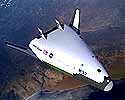| . |  |
. |
Washington - May 21, 1999 -  Washington - May 21, 1999 - Lockheed Martin told Congress Thursday the VentureStar reusable space vehicle project was unable to attract Wall Street investors and would need some form of added government funding or loan backing.
Washington - May 21, 1999 - Lockheed Martin told Congress Thursday the VentureStar reusable space vehicle project was unable to attract Wall Street investors and would need some form of added government funding or loan backing.Without the help, the project would not be able to go forward, Peter B. Teets, Lockheed Martin President and Chief Operating Officer told the U.S. Senate Commerce and Science Committee. The statement was the first time Lockheed managers admitted that the operational VentureStar project could not be developed with Lockmart money alone. "Wall Street has spoken," Teets said Thursday. "They have picked the status quo-they will finance systems with existing technology. They will not finance VentureStar." Teets said "for VentureStar to succeed, it will be necessary to have some form of government-backed loan guarantee." The guarantee would allow Lockheed to have access to capital without having to pay the high capital rates, rates charged to high risk ventures. Teets statement before the Senate was tantamount to admission that his company's $230 million investment in the subscale VentureStar test craft, the X-33, would not be matched by additional billions in company funds for the full size vehicle. NASA will have funded $1 billion for the X-33 by the time the project's 15 test flights are concluded in 2001. When asked by Sen. John Breaux (D-La.) why a big company like Lockheed couldn't just borrow the development money for VentureStar, Teets admitted that the firm was not about to create billions of debt to build the spacecraft. "We had about a billion and a half of cash flow last year," Teets told Breaux, "and we spent about a billion of it to retire debt. We don't want to create new debt." But not everyone was in favor of the government helping out VentureStar. Boeing's R. Gale Schluter, head of their launch vehicle operation in Huntington Beach, California, said that government funding for RLV technology should be open to everyone, not just the VentureStar-type project. Under the terms of the X-33 contract, Lockheed will have exclusive access to the advanced technologies that will come out of the test project, even though it was mainly paid for by taxpayer funds. The company plans to use that X-33 technology to build the full size - but privately owned - VentureStar. That is, if there is enough money available by then.
Reuseable Launch Vehicle Archive at Spacer.Com
X-3X Rotary Kistler Other Space Planes General RLV Industry Issues
 Baikonur - May 21, 1999 -
Baikonur - May 21, 1999 - An ILS Proton successfully launched Nimiq-1, a direct TV satellite for Telesat Canada, today from Baikonur Cosmodrome in Kazakstan. Lifting off on time at 4.30am local (6.30pm EDT May 20). Built by Lockheed Martin Commercial Space Systems, the satellite from 91 degrees West will provide 100s of direct TV satellite channels to Canadians from coast to coast. |
|
|
|
|
|
|
|
|
|
|
|
|
|
| The content herein, unless otherwise known to be public domain, are Copyright 1995-2006 - SpaceDaily.AFP and UPI Wire Stories are copyright Agence France-Presse and United Press International. ESA PortalReports are copyright European Space Agency. All NASA sourced material is public domain. Additionalcopyrights may apply in whole or part to other bona fide parties. Advertising does not imply endorsement,agreement or approval of any opinions, statements or information provided by SpaceDaily on any Web page published or hosted by SpaceDaily. Privacy Statement |